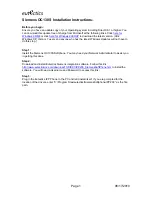
isis priority
■
Use to set the priority of use for your designated router.
■
You can configure an individual priority for level 1 and level 2 by choosing a
priority level in the range 0–127.
■
The default priority level is 64.
■
Specifying the
level 1
or
level 2
keyword resets the priority only for level 1 or
level 2 routing, respectively.
■
Priorities are used to determine which router in the network is the designated
intermediate system (DIS); the router with the highest priority becomes the DIS.
Priorities are advertised in hellos.
■
IS-IS has no backup designated router. Setting the priority to 0 reduces the chance
of this router becoming the DIS, but does not prevent it. If a router with a higher
priority is identified, it takes over the role from the current DIS. When priorities
are equal, the highest MAC address breaks the tie and becomes the DIS.
■
Example
host1(config-if)#
isis priority 80 level-1
■
Use the
no
version to restore the default value, 64.
■
See isis priority
Configuring Passive Interfaces
You can configure an IS-IS passive interface. A passive interface only advertises its
IP address in its LSPs; it does not send or receive IS-IS packets.
Optionally, you can set a route tag for an IS-IS passive interface by including the
tag
keyword and a numeric tag value in the
passive-interface
command.
Passive interfaces have a metric of zero by default. You can set a different metric
for a particular passive interface by specifying the value along with the
metric
keyword. A global default metric set with the
metric
command does not affect any
passive interface. Similarly, configuring a reference bandwidth for IS-IS has no effect
on passive interfaces. Metrics specified for a passive interface apply to both level 1
and level 2 interfaces unless you restrict the metric to a single level.
passive-interface
■
Use to configure an IS-IS interface so that its IP address is advertised in its
link-state PDUs but no IS-IS packets are sent from or received on the interface.
■
Use the optional
tag
keyword to specify a tag value for an IS-IS passive interface
before the route is propagated to other routers in an IS-IS domain. The tag value
must be a number in the range 1–4294967295.
■
Use the optional
metric
keyword to specify a metric value for an IS-IS passive
interface. The metric value must be a number in the range 1–16777215. This
value overrides the default metric of zero.
352
■
Configuring IS-IS Interface-Specific Parameters
JUNOSe 11.0.x IP, IPv6, and IGP Configuration Guide
Содержание IGP - CONFIGURATION GUIDE V11.1.X
Страница 6: ...vi...
Страница 8: ...viii JUNOSe 11 0 x IP IPv6 and IGP Configuration Guide...
Страница 18: ...xviii List of Figures JUNOSe 11 0 x IP IPv6 and IGP Configuration Guide...
Страница 20: ...xx List of Tables JUNOSe 11 0 x IP IPv6 and IGP Configuration Guide...
Страница 26: ...2 Internet Protocol JUNOSe 11 0 x IP IPv6 and IGP Configuration Guide...
Страница 148: ...Set clauses set local pref 400 See show route map 124 Monitoring IP JUNOSe 11 0 x IP IPv6 and IGP Configuration Guide...
Страница 228: ...204 Internet Protocol Routing JUNOSe 11 0 x IP IPv6 and IGP Configuration Guide...
Страница 264: ...240 Monitoring RIP JUNOSe 11 0 x IP IPv6 and IGP Configuration Guide...
Страница 438: ...414 Monitoring IS IS JUNOSe 11 0 x IP IPv6 and IGP Configuration Guide...
Страница 439: ...Part 3 Index Index on page 417 Index 415...
Страница 440: ...416 Index JUNOSe 11 0 x IP IPv6 and IGP Configuration Guide...
Страница 454: ...430 Index JUNOSe 11 0 x IP IPv6 and IGP Configuration Guide...
















































